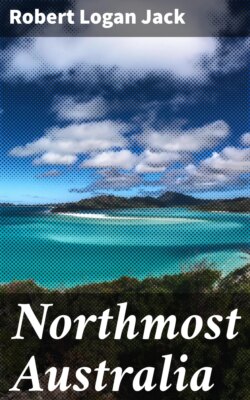Читать книгу Northmost Australia - Robert Logan Jack - Страница 42
На сайте Литреса книга снята с продажи.
SURGEON HAMILTON
Оглавление"3rd September. We steered from these hostile savages to other islands in sight, and sent some armed men on shore...without success. This island we called PLUMB ISLAND, from its bearing an austere, astringent kind of fruit, resembling plumbs, but not fit to eat.
"In the evening, we steered for these islands which we supposed were called the PRINCE OF WALES ISLANDS, and about 2 o'clock in the morning [4th September. 'Before midnight,' says the Captain], came to anchor, with a grappling, alongside of an island, which we called LAFORY'S ISLAND [HORN ISLAND]. As the night was very dark, and this was the last land that could afford us relief, all hands went to sleep.
"The morning [4th September] was ushered in with the howling of WOLVES, who had smelt us in the night...Lieutenant Corner and a party were sent at daylight to search again for water; and, as we approached, the wild beasts retired and filled the woods with their hideous growling."
Water was discovered on digging in a hollow. Signs of recent human presence were also observed.
"After having gorged our parched bodies with water till we were perfectly waterlogged, we began to feel the cravings of hunger—a new sensation of misery we had hitherto been strangers to, from the excess of thirst predominating. We found a harsh, austere, astringent fruit, resembling a plumb...We permitted the men to fill their bellies with them. There was also a small berry, of similar taste to the plumb...We carefully avoided shooting at any bird, lest the report...should alarm the natives, whom we had every reason to suspect were at no great distance...When every other thing was filled with water, the carpenter's boots were also filled. The water in them was first served out, on account of leakage.
"There is a large sound here, to which we gave the name of SANDWICH'S SOUND [now FLINDERS PASSAGE], and commodious anchorage for shipping in the bay, to which we gave the name of WOLF'S BAY, in which there is from 5 to 7 fathoms water all around. This is extremely well situated for a rendezvous in surveying Endeavour Straits; and were a little colony settled here, a concatenation of Christian settlements would enchain the world and be useful to any unfortunate ship;...or should a rupture take place with South America, a great vein of commerce might find its way through this channel.
"HAMMOND'S ISLAND lies NW. by W., PARKER'S ISLAND [WEDNESDAY ISLAND?] from N. and by W. to N. and by E., and an island seen to the north entrance NW. We supposed it to be an island called by Captain Bligh MOUNTAINOUS ISLAND [now BANKS ISLAND.—R. L. J.], laid down in latitude 10° 16' S. [The island now charted as Hammond Island may or may not be the one so named on this occasion, as the above confused description does not tally with anything when the bearings are plotted on the modern chart. The name, however, has been perpetuated, but must be regarded as a 'complimentary' one.—R. L. J.]
"SANDWICH'S SOUND is formed by Hammond's, Parker's and a cluster of small islands on the stat board hand at its eastern entrance. We also called a back land behind Hammond' s Island and the other islands to the southward of it, CORNWALLIS LAND. The uppermost part of the mountain was separated from the main by a large gap. Under the gap, low land was seen; but whether that was a continuation of the main or not we could not determine. Near the centre of the sound is a small, dark-coloured, rocky island. [By a 'back land,' Hamilton probably meant a land
behind the boats, and on this assumption his CORNWALLIS LAND was probably PRINCE OF WALES ISLAND.—R. L. J.]
"This afternoon, at 3 o'clock, being the 4th of September, our little squadron sailed again, and in the evening saw a high-peaked island lying NW., which we called HAWKESBURY'S ISLAND [It rises to 560 feet]. The passage through the north entrance [i.e., between Flinders Passage and Prince of Wales Channel.—R. L. J.] is about 2 miles wide. After passing through it, saw a reef. As we approached it, we shallowed our water to 3 fathoms; but on hauling up more to the SW. we deepened it again to 6 fathoms. Saw several large turtle, but could not catch any...After clearing the reef, stood to the westward. Mountainous Island [BANKS ISLAND] bore N.½E.; Captain Bligh's WEST ISLAND, which appears in three hummocks, NNW.; a rock [RED WALLIS ISLAND] NW., at the SW. extreme of the mainland, S. and by E.; and the NORTHERNMOST CAPE OF NEW SOUTH WALES SSE. [Not really Cape York, but the projecting hump of land west of the mouth of the Jardine River and south of Cook's Possession Island.—R. L. J.]; and to the extreme of the land in sight, the eastward E.JN., a small distance from the nearest of the Prince of Wales Islands, we discovered another island, and which we called CHRISTIAN'S ISLAND. Saw two hummocks [DUNCAN ISLANDS, or PHIPPS and SPENCER ISLANDS.—R. L. J.] between Hawkesbury's Island and Mountainous Island; but could not be certain whether it was one or two islands.
"We now entered the great Indian Ocean, and had a voyage of 1,000 miles to undertake in our open boats. As soon as we cleared the land, we found a very heavy swell running, which threatened destruction to our little fleet; for should we have separated, we must inevitably perish for want of water, as we had not utensils to divide our slender stock. For our mutual preservation, we took each other in tow again."
